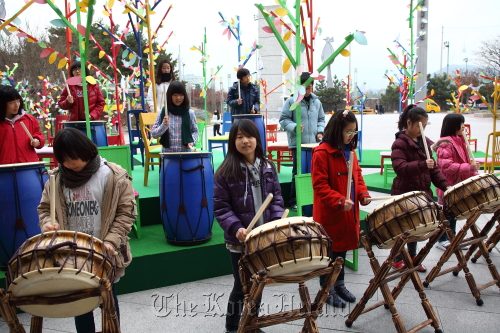Marginalized people have had more opportunities to enjoy arts performances in the past three years, according to a new report.
About 25 percent of households earning less than 1 million won per month went to see cultural performances in 2010, an increase from 19 percent in 2008, the Ministry of Culture, Sports and Tourism report released Thursday showed.
Among people living in counties, who are less exposed to cultural events, 57 percent gained access to cultural performances last year, up from 49 percent in 2008.
With the economic downturn hitting low-income households hardest in early 2008, the government in May, 2008, started offering “culture vouchers” for the poor to help them see exhibitions at national museums and art galleries for free.
 |
Children play drums at an event in Seoul in December as part of the Culture Ministry’s arts and culture education support program for students and seniors. (Ministry of Culture, Sports and Tourism) |
This led to a 25 percent growth in the number of visitors to national museums and art galleries for the past three years, the ministry said.
The number of culture voucher recipients jumped to 470,000 in 2010 from 220,000 in 2008 and the number of tourism/travel voucher recipients more than doubled to 113,000 in 2010 from 46,000 in 2008.
To enhance culture and arts education, the government hired 4,156 arts instructors in 5,436 elementary, middle and high schools in 2010, an increase from 2,243 arts instructors in 3,689 schools in 2008.
Another policy focus of the Culture Ministry was to strategically nurture the content industry.
While the overall Korean economy was reeling from the global financial crisis in 2008 and 2009, the local content industry expanded 7.8 percent to a 69 trillion won market in 2009 from 2007, the ministry said.
Among them, Korea’s content exports amounted to 26 trillion won in 2009, up from 20 trillion won in 2007. In particular, sales of game products shipped out to the global market reached $1.2 billion in 2009.
Korean TV dramas initiated the Korean Wave but K-pop recently gained momentum to create a second Korean Wave, it said.
As the government diversified ways to support research and development for next generation technologies for new content, the national budget has been increased 79 percent to 72.5 billion won in 2010 from 40.4 billion won in 2008, the ministry said.
As the demand for next generation content for smartphones and 3-D displays is expected to surge in the near future, the ministry will intensively support 3-D content industry, it said.
In the area of tourism, the “Visit Korea Year 2010-2012” policy helped bring in international travelers.
The ministry said Korea added 2.4 million international visitors in 2010, compared to 2007.
Among them, there was a surge in Chinese travelers, as Chinese were able to visit Korea with an easier visa process.
The number of Chinese visitors jumped to 1.9 million in 2010 from 1.3 million in 2009.
From 2008 to 2010, Korea’s cultural image was boosted as 11 Korean cultural assets were listed on the UNESCO Heritage.
A total of 1,086 Korean cultural assets were returned from other countries during the past three years.
The Korean Culture and Information Service, a state-run agency promoting Korea overseas, plans to newly open eight cultural centers overseas this year. The eight centers will be located in Australia, the Philippines, Indonesia, Spain, India, Mexico, Turkey and Hungary.
By Kim Yoon-mi (
yoonmi@heraldcorp.com)








![[Weekender] Korea's traditional sauce culture gains global recognition](http://res.heraldm.com/phpwas/restmb_idxmake.php?idx=644&simg=/content/image/2024/11/21/20241121050153_0.jpg)